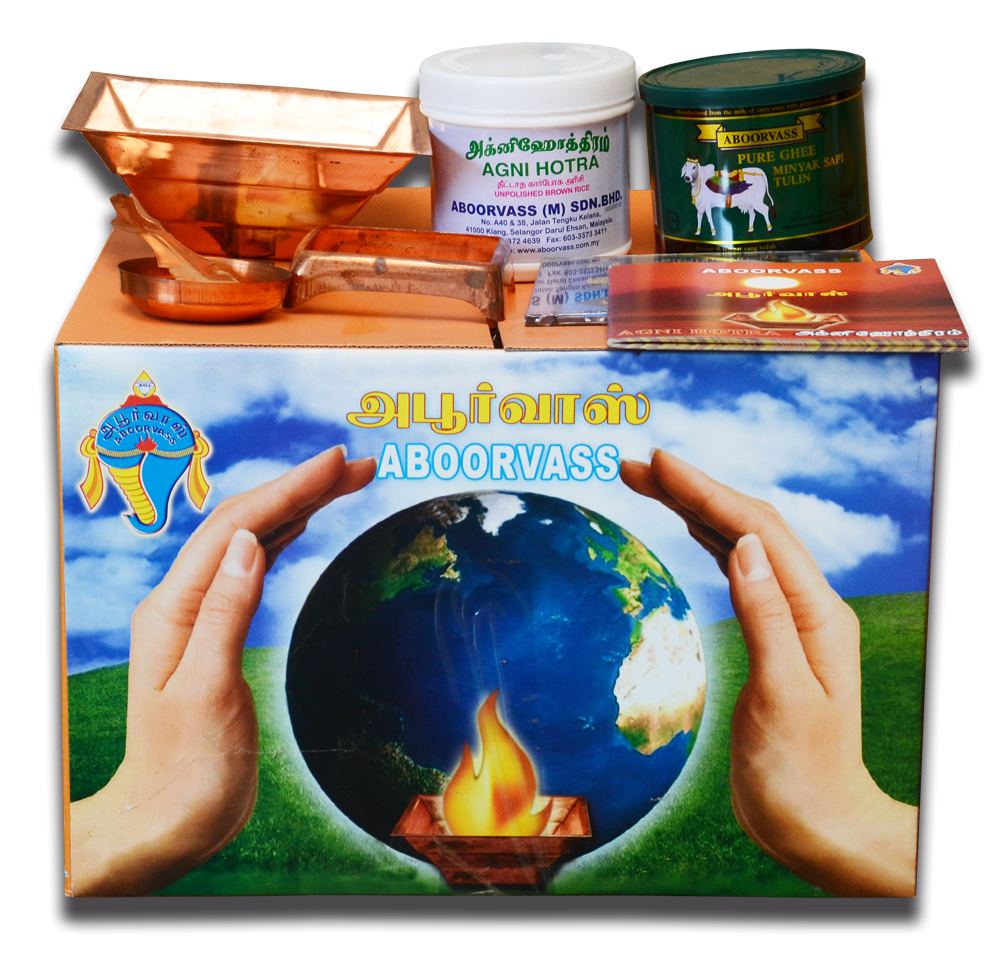
AGNIHOTRA
Perform Agni Hotra Heal Yourself
Heal the environment
Agnihotra forms the basis of homa therapy, a process of healing the environment and bringing the energy cycle into balance. When the environment is healed, we are healed, too. Even the ash from this practice has many uses. The word homa is synonymous with yagna which is an ancient Vedic practice of cleansing the environment of pollution while paying respects to God at the same time and is still carried out to this day.
As the Vedas are as old as creation itself, we can safely assume that Agnihotra is exactly the same age. Over time, this knowledge was lost but is now slowly gaining popularity. Agnihotra, the most basic form of homa therapy, is tuned to both the rhythm of sunrise and sunset and is accompanied by the chants of mantras.
A side benefit of home therapy is that we, as the Self, are healed as a whole. The Self has five layers: a physical body, mental body, energy body, wisdom body, and bliss body. Cleansing them is not as easy as it sounds. Once a thought is implanted or we are affected by anything in particular, ridding the thought from the mind is not the only step; the thought has to be eradicated from the five layers of the Self. Agnihotra provides a perfect healing and cleansing environment.
Agnihotra is the simplest form of Yagna that anyone from any walk of life irrespective of religion can do. Agnihotra process heals the atmosphere from his/her home. Thousands of people all over the world have experienced that Agnihotra reduces stress, leads to greater clarity of thought, improves overall health, gives one increased energy, and makes the mind full of love. It is a great aid to drug and alcohol de-addiction. Agnihotra also nourishes plant life and neutralizes harmful radiation and pathogenic bacteria. It harmonizes the functioning of Prana (life energy) and can be used to purify water resources.
Tremendous amounts of energy are gathered around the Agnihotra copper pyramid just at Agnihotra time (sunrise and sunset). A magnetic type field is created which neutralizes negative energies and reinforces positive energies. This energy can further be enhanced by chanting Sanskrit mantras. Therefore a positive pattern is created by one who does Agnihotra merely by his/her performance. Agnihotra purifies the atmosphere of pollutants and neutralizes harmful radiation. The resultant atmosphere gives nourishment to all life forms.
WHAT ARE THE BENEFITS?
- The environment is purified of pollution, giving fresh air.
- Contaminated water is purified.
- Removes self-destructive tendencies.
- Gives the motivation to do away with corrupt habits.
- Clearing the area of negative thought patterns and cleansing the body of negative thoughts that have been imprinted on the human psyche.
- The ash is used in agriculture to further improve the yield without the use of chemicals.
- Ash neutralizes radioactive substances ingested.
- The ash is often used as medicine for both animals and humans; it is also used as vibhuti.
WHAT IS THE BENEFIT OF RECITING MANTRAS DURING AGNIHOTRA?
It is known that practicing Agnihotra at the precise times attunes the human body with the Divine. When the body is in accord with this rhythm, the mind is balanced and peace is felt. It is at this time that mantras should be chanted for maximum benefits. After Agnihotra, Triyambakam mantra can be chanted for 9 or 11 times . This mantra provides protection against untimely death and blesses one with ultimate prosperity.






ABOUT IT
You will need a semi-pyramidal copper pot, two round containers – one for a small amount of uncooked brown rice and the other for cow’s ghee – and cow dung. Five to ten minutes before sunrise, break the dried cow dung and arrange it within the copper pot leaving a hollow center. Light a piece of cow dung dipped in ghee, and insert it into the hollow center. Keep the fire alive until the sunrise or sunset timings using ghee. The best way to perform it is to start between 6-10 minutes before the timings so that the fire is lit well.
At sunrise, smear the rice with ghee, divide it into two portions and chant the following mantra:
Suryaaya Swaha Suryaaya Idam Na Mama
Prajatpathaye Swaha Prajatpathaye Idam Na Mama
Upon uttering Swaha of the first line, offer the rice to the fire and repeat with the second line.
For the evening rituals, the mantra varies but the process remains the same.
“Agnaye Swaha Agnaye Idam Na Mama
Prajatpathaye Swaha Prajatpathaye Idam Na Mama”
The above mantra is for the evening.
Once this is complete, sit and meditate upon the fire until the offerings are completely burnt and the fire has died out. Do not forcefully extinguish the fire.
The area in which Agnihotra is performed should be kept clean and tidy. A bath should be taken for cleansing before performing the rituals; if that is not possible, wash the face, hands, and feet.
People from all walks of life can perform Agnihotra regardless of their socio-economic status. However, it is advised that menstruating women avoid this ritual.
TRIYAMBAKA HOMAM
There are many of us who fight with time as a result of work and studies. As a result, it seems near impossible to follow the actual sunrise and sunset timing to perform Agnihotra. Nevertheless, there is always a solution. If someone wishes to perform Agnihotra at an earlier time, they can perform the Triyambakam Homam. This follows the same steps of Agnihotra, with only the variation of the mantra being chanted. Here, the Mrithyunjaya Mantra is chanted. Mrithyu means death and jaya means victory. Thus, the mantra gives victory over death and evades unforeseen accidents when chanted with faith and patience.
Mrithyunjaya Manthra
“Triyambakam Yajaamahe Suganthim Pushtivarthanam
Uruvaaru Gameve Bandanaarth Mrityor Mookshiya Ma Mrithaath”
At the end of the mantra, swaha should be said and at the same time, the rice offerings towards the fire should be given. The portion of the rice should also be divided into two and swaha be said at the end of each mantra. This marks the end of the Triyambaka Homam.
FAQ ABOUT AGNIHOTRA
What will happen if I miss Agnihotra or perform Agnihotra in the wrong way, will there be any negative effects?
You will get healing benefits from only those Agnihotras which you performed correctly. However, there are no negative effects if you miss Agnihotra or if you do not perform Agnihotra as told; you simply won’t get any healing benefits from that specific Agnihotra.
How long does it take to see the results of Agnihotra?
Normally after fifteen days of the regular performance of Agnihotra you will experience the healing benefits.
How long should I perform Agnihotra?
There is no stipulated time into performing Agnihotra. However, you can practice it for as long as you want to experience the good benefits of Agnihotra.
Can it be done in any room in any direction or should there be a specific direction we have to face while doing it?
There are neither such requirements nor restrictions. You may choose to do in any room or ouside in your back yard or your balcony. There are no restrictions. However, it is best to face the east and do Agnihotra since that is the direction of the sunrise.
Should we be using only brown rice or any rice would do?
Brown rice is the best to be offered. In some cases where brown rice is not available then, unboiled white rice can be used.
Do I have to clean the pyramid every day?
Just shake off the excess burnt ashes and it is ready to use again, scrape off any cowdung chunks attached, do not alter the shape of the pyramid any way and do not hit the corners to make the dried ashes drop.
What do I do with the ashes?
The ashes can be added to a compost pit along with other dried sticks. After some time, it will decompose and is a very good fertilizer. Some people also add the ash to contaminated water and drink it, thus making the water free of germs.

Strategies of organic farming in fruit crops
Sandhya Bhat, KK Misra and Vikas Kumar Sharma
Organic agriculture has grown..

Agnihotra Ash and Water Soluble Phosphates
Dr. Tung Ming Lai, Denver, Colorado, USA
I did some lab testing on Agnihotra ash.
The results are interesting. 0.1g of ash…

Study the effects of Yadnya fumes on SOx and NOx levels in the surrounding environment.
Abhang Pranay, Pathade Girish